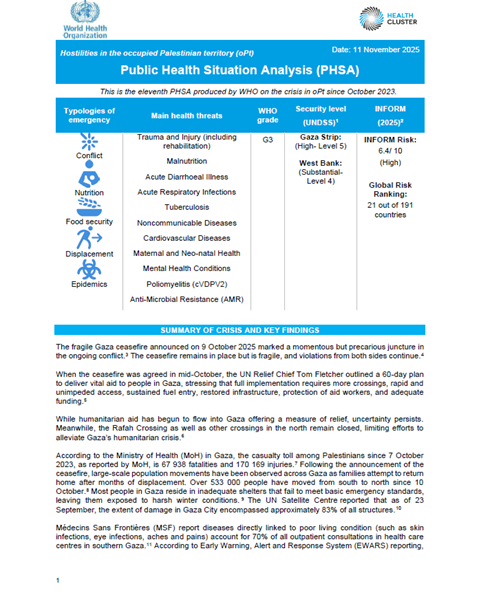Public Health Situation Analysis - oPt
11 November 2025

Overview
The fragile Gaza ceasefire announced on 9 October 2025 marked a momentous but precarious juncture in the ongoing conflict.3 The ceasefire remains in place but is fragile, and violations from both sides continue.
When the ceasefire was agreed in mid-October, the UN Relief Chief Tom Fletcher outlined a 60-day plan to deliver vital aid to people in Gaza, stressing that full implementation requires more crossings, rapid and unimpeded access, sustained fuel entry, restored infrastructure, protection of aid workers, and adequate funding.
While humanitarian aid has begun to flow into Gaza offering a measure of relief, uncertainty persists. Meanwhile, the Rafah Crossing as well as other crossings in the north remain closed, limiting efforts to alleviate Gaza’s humanitarian crisis.
According to the Ministry of Health (MoH) in Gaza, the casualty toll among Palestinians since 7 October 2023, as reported by MoH, is 67 938 fatalities and 170 169 injuries. Following the announcement of the ceasefire, large-scale population movements have been observed across Gaza as families attempt to return home after months of displacement. Over 533 000 people have moved from south to north since 10 October. Most people in Gaza reside in inadequate shelters that fail to meet basic emergency standards, leaving them exposed to harsh winter conditions. The UN Satellite Centre reported that as of 23 September, the extent of damage in Gaza City encompassed approximately 83% of all structures.
Médecins Sans Frontières (MSF) report diseases directly linked to poor living condition (such as skin infections, eye infections, aches and pains) account for 70% of all outpatient consultations in health care centres in southern Gaza. According to Early Warning, Alert and Response System (EWARS) reporting acute watery diarrhea and acute respiratory infections are 17.5% of all consultations in Gaza as of October 2025.
